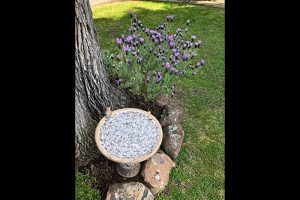Lavender is well known for its very aromatic fragrance and can be a ‘love-it-or-leave-it” plant for some, based on the fragrance alone. But please don’t let that deter you. It is a landscape stunner! But, best of all, it is drought tolerant and, once established, it doesn’t need to be watered very often. With another imminent drought year in California, choosing lavender is a win/win. Companion planting with lavender is a natural in a landscape with other drought-tolerant plants. Given full sun, good drainage (they don’t like wet feet) and room to grow, they thrive with little care, even through summer. Lavender also attracts a wide range of pollinators and beneficial insects: bumblebees, honeybees, butterflies, ladybugs and praying mantises to name a few. And, it is considered deer and rabbit resistant. What’s not to love?
There are more than 450 named lavender varieties or cultivars. The foliage colors range from various shades of green through gray-green to silver and even variegated cultivars. Flower colors have a wide range beyond just lavender to a spectrum of blues and purples to whites and pinks, reds and plums. They have a variety of sizes: dwarf lavenders, medium-sized lavenders, and lavenders that grow quite substantially to fit into any landscape design. From pathways and borders, hedges and rock gardens, sloping walls and rolling hills, to raised beds and containers. There is a lavender plant for all your landscape needs. I add more lavender plants every year, and I am ready to leave for the nearest garden center or grower right now!
Lavandula angustifolia-English lavender (true or common lavender). These are grown all over the world, in various climates, for their prized essential oils and beauty in the garden. They are also a great choice for culinary use. Some are smaller or dwarf varieties, making them great for containers, and some grow much larger making them ideal for a border or hedge.
Lavandula stoechas-Spanish lavender (butterfly lavender, French lavender, topped lavender). Easily identified by its cylindrical flower heads wrapped with tiny flowers, topped with leaf-shaped petals that look like rabbit ears or butterfly wings. Earliest of the lavenders to bloom and will bloom early spring through summer.
Lavandula xintermedia-or lavandula, a cross between L. Angusifolia and L. latifolia (spiked lavender). They tend to grow larger, bloom later and produce more spikes than other lavenders. These are the most widely distributed lavender.
Lavandula dentata-French lavender, has a wooly leaf texture, toothed leaves and pale violet bracts. Blooms late spring through summer.
One of the best times to make your selection is spring. However, bloom times vary by cultivar. Your local garden centers and growers will have an array ready for planting and will be appropriate for your climate zone (be sure to consider any microclimates you may have). In addition, locally, you can probably see lavender growing in your neighborhood or in town. There is a local winery in Murphys off of Highway 4 (Locke Vineyards), and they grow more than 9 varieties. In May/June, you are in for a stellar show of lavender blooms if you drive by or are visiting the area. L. xintermedia ‘Grosso’ and L. xginginsii ‘Goodwin Creek’ are two of their more predominant, prolific varieties.
So, consider adding lavender to your landscape. With very little effort It is the gift that keeps on giving, year after year!
Ann Arshakuni is a University of California Cooperative Extension Master Gardener of Calaveras County.
UCCE Master Gardeners of Tuolumne and Calaveras Counties can answer home gardening questions. Call 209-533-5912 or fill out our easy-to-use problem questionnaire here. Check out our website here. You can also find us on Facebook.

